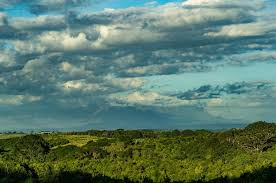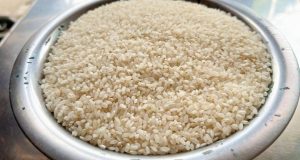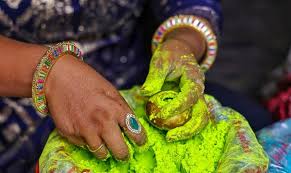Today’s Current Affairs: 29th March 2024 for UPSC IAS exams, State PSC exams, SSC CGL, State SSC, RRB, Railways, Banking Exam & IBPS, etc
Table of Contents
South East Africa Montane Archipelago: Study

A recent study in southern Africa has unearthed a wealth of previously undocumented biodiversity in a newly recognised ecoregion called the South East Africa Montane Archipelago (SEAMA).
- South East Africa Montane Archipelago (SEAMA) is a newly recognised mountainous ecoregion.
- It stretches across northern Mozambique to Mount Mulanje in Malawi, southern Africa’s second-highest mountain.
- The ecoregion encompasses 30 granitic inselbergs reaching > 1000 m above sea level, hosting the largest (Mt Mabu) and smallest (Mt Lico) mid-elevation rainforests in southern Africa, as well as biologically unique montane grasslands.
- SEAMA has distinctly higher annual rainfall and humidity, especially in the dry season, compared to surrounding regions.
- Since 2000, the SEAMA has lost 18% of its primary humid forest cover (up to 43% in some sites)—one of the highest deforestation rates in Africa.
- The major cause of montane forest loss in SEAMA is slash and burn shifting agricultural practices, typically used for subsistence food production by local communities, along with charcoal production, for household cooking, and as a source of revenue.
- Inselberg, or Monadnock, is an isolated, steep-sloped ridge, hill, or small mountain that stands above well-developed plains.
- It appears like an island rising from the sea.
Solar And Heliospheric Observatory:

A citizen scientist spotted a comet in an image from the Solar and Heliospheric Observatory (SOHO) spacecraft.
- Solar and Heliospheric Observatory (SOHO) is a project of international collaboration between the European Space Agency (ESA) and the U.S. National Aeronautics and Space Administration (NASA). It was launched in December 1995, SOHO was designed to study the Sun.
- In order to provide continuous observations, it was maneuvered to orbit the first Lagrangian point (L1), a point some 1.5 million km (900,000 miles) from Earth toward the Sun where the gravitational attraction of Earth and the Sun, combine in such a way that a small body remains approximately at rest relative to both.
- It carries 12 scientific instruments to study the solar atmosphere, helioseismology and the solar wind.
- Though its mission was scheduled to run until only 1998, it has continued collecting data, adding to scientists’ understanding of our closest star, and making many new discoveries, including thousands of comets.
- It is the longest-lived Sun-watching satellite to date.
Polar Vortex:

The polar vortex circling the Arctic is swirling in the wrong direction after warming in the upper atmosphere triggered a major reversal event recently.
- The polar vortex is a large area of low pressure and cold air surrounding both of the Earth’s poles. It weakens in summer and strengthens in winter.
- The term “vortex” refers to the counter-clockwise flow of air that helps keep the colder air near the poles.
- Many times, during winter in the northern hemisphere, the polar vortex will expand, sending cold air southward with the jet stream.
- This occurs fairly regularly during wintertime and is often associated with large outbreaks of Arctic air in the United States and Canada.
- Portions of Europe and Asia also experience cold surges connected to the polar vortex.
- The polar vortex extends from the tropopause (the dividing line between the stratosphere and troposphere) through the stratosphere and into the mesosphere (above 50 km).
- Low values of ozone and cold temperatures are associated with the air inside the vortex.
- Jet streams are narrow bands of strong wind that generally blow from west to east all across the globe.
Order Of The Druk Gyalpo : Bhutan’s Highest Civilian Award

The Prime Minister of India received Bhutan’s highest civilian award, the ‘Order of the Druk Gyalpo’, during his two-day State visit to Bhutan.
- He is the first foreign Head of the Government to receive the honour.
- India and Bhutan have also exchanged several MoUs and signed agreements in the fields of energy, trade, digital connectivity, space and agriculture, and finalised the MoU on the establishment of rail links between the two nations.
- The Order of the Druk Gyalpo stands as Bhutan’s most esteemed civilian accolade, reserved for individuals who have demonstrated exceptional contributions to society, embodying values of service, integrity, and leadership.
- Recipients of this prestigious award are carefully selected based on their outstanding accomplishments and positive impact on society.
- Their contributions are assessed in alignment with Bhutanese values, emphasising holistic development, cultural preservation, and regional harmony.
Mushk Budiji Rice : Role Of Temp And Altitude

Scientists reported that altitude and temperature play an important role in the development of mushk budiji aroma.
- Mushk budiji Rice is short, bold aromatic rice grown in the higher reaches of Kashmir valley.
- It possesses a harmonious blend of taste, aroma and rich organoleptic properties.
- It is mainly grown in areas of Sagam, Panzgam and Soaf Shali of district Anantnag.
- The consumption of aromatic rice in Kashmir has now been limited to special occasions, marriages and festivals. It has received a Geographical Indication (GI) tag.
- Scientists conduct a study of selected locations on the flavour profile of mushk budiji using gas chromatography-mass spectroscopy (GC-MS) and an ‘electronic nose’.”
- Based on these studies, the scientists identified 35 volatile organic compounds (VOCs) in mushk budiji rice samples.
- Acetyl-1-pyrroline (2-AP) is a known aromatic compound found in some varieties but it was present only in mushk budiji samples collected from higher altitudes.
Gulaal Gota : Tradition Of Celebrating Holi

In Jaipur, Rajasthan, the age-old tradition of celebrating Holi continues.
- This celebration involves the practice of “Gulaal Gota,” a unique tradition dating back around 400 years.
- Gulaal Gota is a small ball made of lac, filled with dry gulaal, and weighs around 20 grams when filled.
- Lac is a resinous substance that is secreted by certain insects.
- The female scale insect is one of the sources of lac.
- To produce 1 kg of lac resin, around 300,000 insects are killed.
- The lac insects also yield resin, lac dye and lac wax.
- It is used in various applications, including the production of lac bangles.
- The process of making Gulaal Gotas involves boiling lac in water to make it flexible, shaping it, adding colour, heating it, and then blowing it into a spherical shape with the help of a blower called “phunkni”.
- Lac, the primary raw material for Gulaal Gota, is sourced from Chhattisgarh and Jharkhand.
- Gulaal Gotas are made by Muslim lac makers, known as Manihaars, in Jaipur, who learned lac-making from Hindu lac makers in Bagru, a town near Jaipur.
START 2024 Programme:

The Indian Space Research Organisation (ISRO) will conduct the Space science and Technology Awareness Training (START) 2024 programme during April and May.
- The START programme is part of the ISRO’s efforts to enable Indian students to become professionals in Space Science and Technology, as the organisation’s Space Science exploration programme continues to expand into new domains.
- The Space Science and Technology Awareness Training (START) is an initiative by the Indian Space Research Organization (ISRO).
- It is an online introductory-level awareness program in space science and technology.
- The START program intends to equip students with foundational knowledge in space-related domains.
- It is specifically designed for undergraduate and postgraduate students of science and technology.
- START will cover various domains, such as space science, that includes Astronomy and Astrophysics, Heliophysics, Instrumentation, Aeronomy, and Sun-Earth interaction.
- The lectures are delivered by scientists from Indian academia and ISRO centres.
- This program is part of ISRO’s efforts to train Indian students to become professionals in the fields of space science and technology.
MGNREGS : Revised Wages

The Union government recently announced revised wages under the Mahatma Gandhi National Rural Employment Guarantee Scheme (MGNREGS), prompting varied responses from different states.
- Several states reported an increase in wages ranging from 8% to 10%.
- The Union Rural Development Ministry obtained special permission from the Election Commission for this routine annual exercise, considering the constraints imposed by the model code of conduct.
- Telangana, Andhra Pradesh, Chhattisgarh, Gujarat, Madhya Pradesh, Maharashtra, Tamil Nadu, and Goa recorded notable hikes ranging from 8% to 10.5%.
- Haryana offers the highest wages at Rs 374 per day, whereas Uttar Pradesh has one of the lowest at Rs 237.
- The revised rates will come into effect from 1st April 2024.
- Despite the revision, the nation-wide average days of employment provided per household in the financial year 2023-24 remained at 51 days, falling short of the promised 100 days.
Extension Of AFSPA In Arunachal Pradesh And Nagaland:

The Ministry of Home Affairs (MHA) has extended the Armed Forces (Special Powers) Act (AFSPA) in certain districts of Arunachal Pradesh and Nagaland for an additional six months, effective from April 1, 2024.
- In Arunachal Pradesh, the AFSPA has been extended for six months in the following areas: Tirap, Changlang, and Longding districts
- Areas under the jurisdiction of Namsai, Mahadevpur, and Chowkham police stations in Namsai district, bordering Assam
- In Nagaland, the AFSPA has been extended for six months in the following districts and police station areas: 8 districts: Dimapur, Niuland, Chumukedima, Mon, Kiphire, Noklak, Phek, and Peren
- The Armed Forces (Special Powers) Act, 1958, grants sweeping powers to security forces in areas deemed as “disturbed”. Under the AFSPA, armed forces personnel are authorized to search, arrest, and open fire if deemed necessary for maintaining public order.




